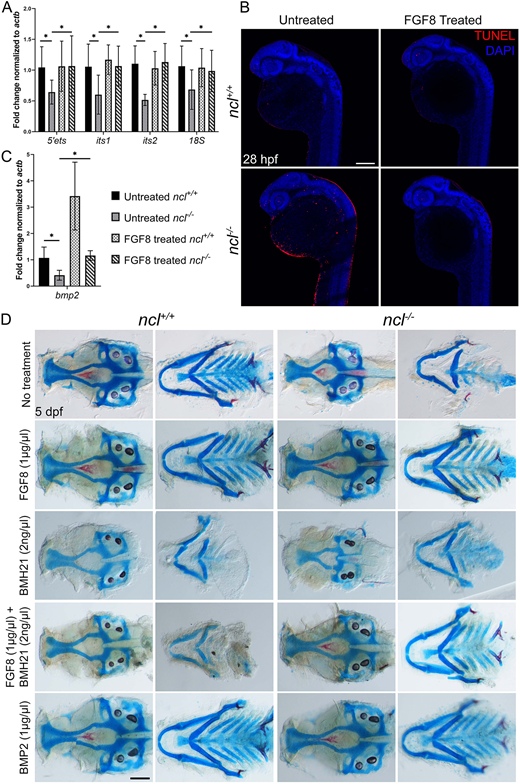Fig. 6
FGF8 rescues rRNA transcription in ncl−/− embryos. (A) qPCR for 5′ETS, ITS1, ITS2 and 18S in untreated and FGF8-treated ncl+/+ and ncl−/− zebrafish (n=10 per sample) indicates rescue of pre-RNA transcription in FGF8-treated ncl−/− zebrafish at 36 hpf. (B) TUNEL staining of untreated and FGF8-treated ncl+/+ and ncl−/− zebrafish at 28 hpf indicates reduced TUNEL+ cells in FGF8-treated ncl−/− embryos compared with untreated ncl−/− embryos (n=15). (C) qPCR for bmp2 in 36 hpf ncl+/+ and ncl−/− embryos (n=10 per sample) that were untreated or treated with 1 µg/µl FGF8 indicates significant downregulation in bmp2 in untreated ncl−/− embryos and significant upregulation in FGF8-treated ncl+/+ embryos. In FGF8-treated ncl−/− embryos, the bmp2 transcript levels were rescued and comparable with untreated ncl+/+ embryos. actb was used as a housekeeping control. (D) Skeletal preparations of 5 dpf ncl+/+ and ncl−/− larvae that were untreated or treated with FGF8, BMH21, FGF8+BMH21 or BMP2. Exogenous FGF8 and BMP2 treatment rescued the cranioskeletal phenotype of ncl−/− larvae (n=45). All experiments were performed three times. Scale bars: 100 µm (B); 70 µm (D). Data are represented as mean±s.d. *P<0.05 (two-tailed, paired Student's t-test).

